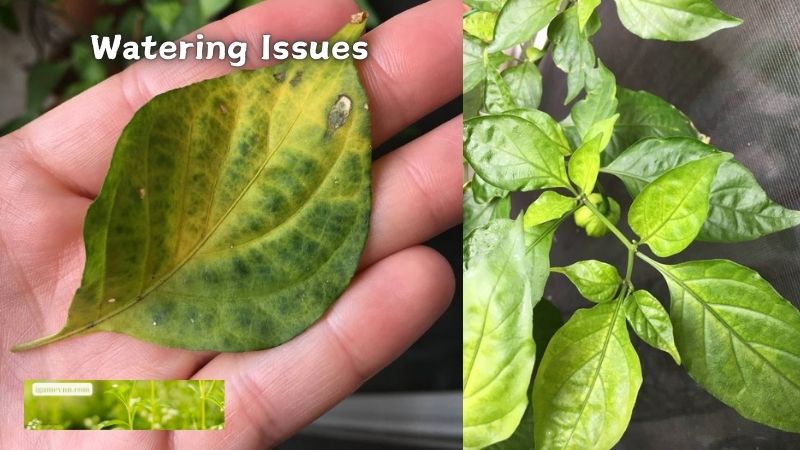Growing chilli plants can be a rewarding experience, whether you are a seasoned gardener or a beginner. However, encountering problems such as yellowing leaves can be frustrating and concerning. The chilli leaves turn yellow is often a cry for help from your plants, indicating that something is amiss. This article from Igamevnn will delve into the various reasons why chilli leaves turn yellow and offer practical solutions to address these issues.
Table of Contents
ToggleWhy Chilli Leaves Turn Yellow
1. Nutrient Deficiency
One of the most common reasons why chilli leaves turn yellow is nutrient deficiency. Chilli plants require a balanced supply of nutrients to thrive, and any imbalance can manifest as yellowing leaves.

Nitrogen Deficiency
Nitrogen is a crucial nutrient for plant growth. A deficiency in nitrogen typically results in the overall yellowing of leaves. This is because nitrogen is a vital component of chlorophyll, the pigment responsible for the green color in plants. When nitrogen is deficient, chlorophyll production decreases, leading to yellow leaves.
Solution: To remedy nitrogen deficiency, use a nitrogen-rich fertilizer. Organic options such as composted manure or blood meal can also be effective.
Iron Deficiency
Iron deficiency usually causes yellowing in new leaves while the veins remain green. This condition is known as chlorosis. Iron is essential for chlorophyll synthesis and overall plant health.
Solution: Apply iron chelate or iron sulfate to the soil. Foliar sprays containing iron can also provide a quick fix.
Magnesium Deficiency
Magnesium is another essential nutrient, and its deficiency can lead to yellowing between the veins of older leaves, a condition known as interveinal chlorosis.
Solution: Use Epsom salts (magnesium sulfate) as a soil amendment or foliar spray to correct magnesium deficiency.
2. Watering Issues
Improper watering is another significant reason why chilli leaves turn yellow. Both overwatering and underwatering can cause stress to the plants, leading to yellow leaves.

Overwatering
Overwatering can cause root rot, a condition where the roots are unable to absorb nutrients effectively due to excess moisture. This can lead to yellowing leaves as the plant struggles to get the necessary nutrients.
Solution: Ensure that your chilli plants are planted in well-draining soil. Water the plants only when the top inch of soil feels dry to the touch. Reduce watering frequency during cooler weather.
Underwatering
On the other hand, underwatering can cause the plants to become stressed and dehydrated, resulting in yellow leaves.
Solution: Establish a regular watering schedule, ensuring the soil remains consistently moist but not waterlogged. Mulching around the base of the plants can help retain moisture.
3. Pests and Diseases
Pests and diseases are common culprits when chilli leaves turn yellow. Various pests can attack chilli plants, causing damage and stress that leads to yellowing leaves.

Aphids and Spider Mites
Aphids and spider mites are small insects that suck sap from the leaves, leading to yellowing and weakening of the plants.
Solution: Regularly inspect your plants for pests. Use insecticidal soap, neem oil, or introduce natural predators like ladybugs to control pest populations.
Fungal and Bacterial Infections
Fungal and bacterial infections can also cause yellow spots or overall yellowing of leaves. Common diseases include powdery mildew, downy mildew, and bacterial leaf spot.
Solution: Use appropriate fungicides or bactericides to treat infections. Ensure good air circulation around the plants and avoid overhead watering to minimize the risk of fungal infections.
4. Soil pH Imbalance
Soil pH plays a crucial role in nutrient availability. An incorrect pH level can prevent chilli plants from absorbing essential nutrients, causing yellow leaves.
Solution: Test the soil pH using a home testing kit or by sending a sample to a laboratory. Chilli plants prefer a slightly acidic to neutral pH (6.0-7.0). Adjust the pH by adding lime to raise it or sulfur to lower it, depending on the results.
5. Environmental Stress
Environmental factors such as temperature extremes and poor light conditions can also cause chilli leaves to turn yellow.
Temperature Extremes
Chilli plants are sensitive to temperature fluctuations. Extremely high temperatures can cause heat stress, while low temperatures can cause cold stress, both of which can lead to yellowing leaves.
Solution: Provide shade during the hottest part of the day and protect plants from frost by covering them or moving them indoors if possible.
Poor Light Conditions
Insufficient light can also lead to yellow leaves, as light is essential for photosynthesis.
Solution: Ensure your chilli plants receive adequate light, ideally six to eight hours of direct sunlight per day. If growing indoors, consider using grow lights.
6. Transplant Shock
Transplanting can be a stressful process for plants, and it is not uncommon for chilli leaves to turn yellow after being moved to a new location. This is known as transplant shock.
Solution: Minimize root disturbance during transplanting. Water the plants thoroughly after transplanting and provide extra care until they recover. Using a root stimulator can also help reduce transplant shock.
Conclusion
When chilli leaves turn yellow, it is a clear indication that something is wrong. By understanding the various causes—nutrient deficiencies, watering issues, pests and diseases, soil pH imbalance, environmental stress, and transplant shock—you can take appropriate action to address the problem. Regular monitoring and proper care will help ensure that your chilli plants remain healthy and productive. By paying attention to the specific needs of your plants, you can enjoy a bountiful harvest of vibrant, healthy chillies.
Related Posts:
- The World of Squash and Pumpkin: A Comprehensive Guide
- Understanding the Causes of The Tree has Curly Leaves
- How to Fertilize NPK for Ornamental Plants: A…
- The Ultimate Guide to Greenhouse Vegetable Growing
- Understanding Lettuce is Bitter and Managing:…
- Fiddle Leaf Fig has Leaf Spots: Causes and Solutions

